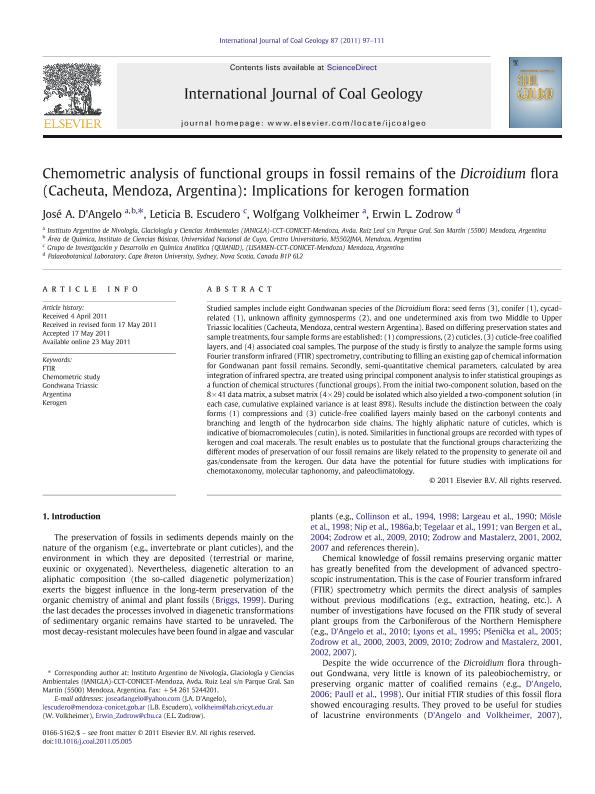Artículo
Chemometric analysis of functional groups in fossil remains of the Dicroidium flora (Cacheuta, Mendoza, Argentina): Implications for kerogen formation
Fecha de publicación:
23/08/2011
Editorial:
Elsevier Science
Revista:
International Journal Of Coal Geology
ISSN:
0166-5162
e-ISSN:
0166-5162
Idioma:
Inglés
Tipo de recurso:
Artículo publicado
Clasificación temática:
Resumen
Studied samples include eight Gondwanan species of the Dicroidium flora: seed ferns (3), conifer (1), cycad-related (1), unknown affinity gymnosperms (2), and one undetermined axis from two Middle to Upper Triassic localities (Cacheuta, Mendoza, central western Argentina). Based on differing preservation states and sample treatments, four sample forms are established: (1) compressions, (2) cuticles, (3) cuticle-free coalified layers, and (4) associated coal samples. The purpose of the study is firstly to analyze the sample forms using Fourier transform infrared (FTIR) spectrometry, contributing to filling an existing gap of chemical information for Gondwanan pant fossil remains. Secondly, semi-quantitative chemical parameters, calculated by area integration of infrared spectra, are treated using principal component analysis to infer statistical groupings as a function of chemical structures (functional groups). From the initial two-component solution, based on the 8×41 data matrix, a subset matrix (4×29) could be isolated which also yielded a two-component solution (in each case, cumulative explained variance is at least 89%). Results include the distinction between the coaly forms (1) compressions and (3) cuticle-free coalified layers mainly based on the carbonyl contents and branching and length of the hydrocarbon side chains. The highly aliphatic nature of cuticles, which is indicative of biomacromolecules (cutin), is noted. Similarities in functional groups are recorded with types of kerogen and coal macerals. The result enables us to postulate that the functional groups characterizing the different modes of preservation of our fossil remains are likely related to the propensity to generate oil and gas/condensate from the kerogen. Our data have the potential for future studies with implications for chemotaxonomy, molecular taphonomy, and paleoclimatology.
Palabras clave:
ARGENTINA
,
CHEMOMETRIC STUDY
,
FTIR
,
GONDWANA TRIASSIC
,
KEROGEN
Archivos asociados
Licencia
Identificadores
Colecciones
Articulos(IANIGLA)
Articulos de INST. ARG. DE NIVOLOGIA, GLACIOLOGIA Y CS. AMBIENT
Articulos de INST. ARG. DE NIVOLOGIA, GLACIOLOGIA Y CS. AMBIENT
Articulos(INQUISAL)
Articulos de INST. DE QUIMICA DE SAN LUIS
Articulos de INST. DE QUIMICA DE SAN LUIS
Citación
D`angelo, José Alejandro; Escudero, Leticia Belén; Volkheimer, Wolfang; Zodrow, Erwin L.; Chemometric analysis of functional groups in fossil remains of the Dicroidium flora (Cacheuta, Mendoza, Argentina): Implications for kerogen formation; Elsevier Science; International Journal Of Coal Geology; 87; 2; 23-8-2011; 97-111
Compartir
Altmétricas




